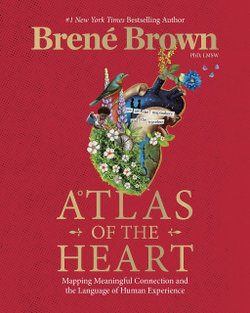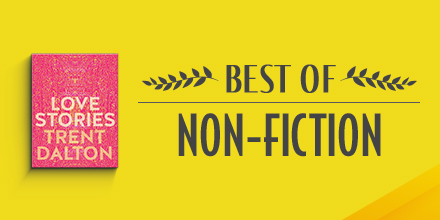Brené Brown is a research professor at the University of Houston, where she holds the Huffington Foundation-Brené Brown Endowed Chair at the Graduate College of Social Work. She is also a visiting professor in management at the University of Texas at Austin McCombs School of Business. Brown has spent the past two decades studying courage, vulnerability, shame and empathy, and is the author of five #1 New York Times bestsellers: The Gifts of Imperfection, Daring Greatly, Rising Strong, Braving the Wilderness and Dare to Lead. Her latest book is called Atlas of the Heart.
Today, thanks to our friends at Penguin Random House, we have a Q&A with Brené Brown to share with you. Read on!
Why is the book called Atlas of the Heart?
In most of my books I’ve shared the line “I am a mapmaker and a traveller.” It’s my way of saying that I don’t have all the answers. I have data and I use that data to chart a course that I’m sharing and trying to navigate at the same time. When I set out to communicate these eighty-seven emotions and experiences, I thought of maps and how beautifully they integrate many layers of information. I want this to be an atlas for all of us, because I believe that, with an adventurous heart and the right maps, we can travel anywhere and never fear losing ourselves.
What is the book about?
Atlas of the Heart is a book about finding our way back to ourselves and to each other, especially in a time when we are experiencing a lot of uncertainty, anxiety, and fear. I wanted to provide an actionable framework for meaningful connection and to explore the language and tools necessary to access a universe where we can share and steward the stories of our bravest and most heartbreaking moments with one another.
What were some of your biggest insights from this new research?
Doing this research and writing this book has taught me that our emotions and experiences are layers of biology, biography, behaviour, and backstory. Every single day, our feelings and experiences show up in our bodies, they’re shaped by where we come from and how we were raised, they drive how we show up, and each feeling has its own unique backstory. We are emotional beings. Understanding these experiences is our life’s work. The more we learn, the deeper we can continue to explore.
I’ve also learned that our connection with others can be only as deep as our connection with ourselves. If I don’t know and understand who I am and what I need, want, and believe, I can’t share myself with you. I need to be connected to myself, in my own body, and learning what makes me work. This is how we develop the grounded confidence we need to move through the world and cultivate meaningful connection with others.
What do we have to gain from having a more granular understanding of the language of emotion?
To form meaningful connections with others, we must first connect with ourselves, but to do either, we must first establish a common understanding of the language of emotion and human experience. Years ago, we collected surveys from over 7,000 people, and the average number of emotions they could recognise in themselves and name was three: mad, sad, and happy. Trying to express the vastness of human emotion and experience through so few words is severely limiting. Without accurate language, we struggle to get the help we need, we don’t always regulate or manage our emotions and experiences in a way that allows us to move through them productively, and our self-awareness is limited. One way this learning has been reflected in my own life is that I am now way more thoughtful in labelling what I am feeling. For example, people often use words like jealous and envious, joy and happiness, sarcasm and irony, or tranquillity and contentedness interchangeably. The research tells us that the more accurately we can name what we are feeling, the better our emotion regulation and psychosocial well-being.
‘To form meaningful connections with others, we must first connect with ourselves, but to do either, we must first establish a common understanding of the language of emotion and human experience.’
How did you choose which emotions and feelings to include?
The list of emotions and experiences that I present in this book first emerged from a content analysis of over 550,000 comments from an online course I taught. The course had a significant component on emotions and connection. After de-identifying the comments (no names) and going through the human subjects approval process, I analysed the data using two questions: What are the emotions and experiences that emerge the most often, and which emotions and experiences do people struggle to name or label? This yielded approximately 150 emotions and experiences. From there, we further honed the list using an invaluable focus group of experienced therapists who work in diverse mental health settings and our internal research team. Once we had the final list, we used the course data to better understand how people actually use language when describing their feelings.
What do you hope readers will take away from the book?
It’s pretty simple—I want us to find a way back to ourselves and each other. We are so much better at causing pain than we are at feeling pain. If we can just turn toward what’s hard in our lives and talk about it with someone we trust, we can change ourselves and the world. I hope this book offers people the language, tools, and courage to lean into our emotions and lean into each other. We don’t have to do this alone. We were never meant to.
What book are you reading right now?
I’m rereading Tarana Burke’s new memoir, Unbound. Tarana is unflinching in her storytelling. As she takes us on the journey that transformed her life and the world, we can feel our own transformation happening. The person who starts this book is not the person who finishes this book.
Was there a song/songs that you listened to often during the writing of this book?
My 16-year-old has started collecting vinyl (insert proud parent emoji), so that inspired me to listen to a lot of my old albums while I was writing. I love all genres of music, from Nick Cave and Leonard Cohen to Mavis Staples and Dolly Parton. And my kids make me great playlists of new music they think I’d like. ‘A-O-K’ by Tai Verdes is a favourite of Charlie’s—I found myself listening to it a lot when I got stuck.
—Atlas of the Heart by Brené Brown (Penguin Books Australia) is out now.

Atlas of the Heart
Mapping Meaningful Connection and the Language of Human Experience
This major new work from the international bestselling author of Gifts of Imperfection and Dare to Lead examines the 87 emotions and experiences that define us, and provides a compelling framework to help us all become more emotionally fluent and connected.
In Atlas of the Heart, Brown takes us on a journey through eighty-seven of the emotions and experiences that define what it means to be human...








 The Best Books of 2021: Non-Fiction
The Best Books of 2021: Non-Fiction
Comments
No comments